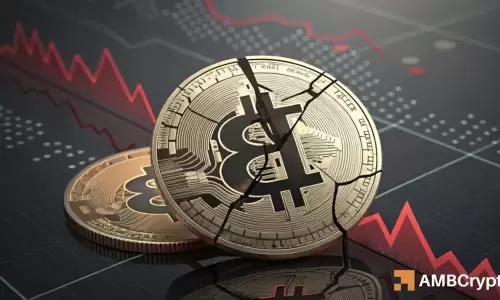 |
|
 |
|
 |
|
 |
|
 |
|
 |
|
 |
|
 |
|
 |
|
 |
|
 |
|
 |
|
 |
|
 |
|
 |
|
Cryptocurrency News Articles
Pi Network: Mining Crypto on Your Phone, Targeting Mass Market Adoption
May 14, 2025 at 02:22 pm
Stanford graduates kicked off the Pi Network in 2019, a crypto project trying to make digital money easier for everyone to get by "mining" on their phones.

Stanford graduates launched the Pi Network in 2019 as a cryptocurrency project aiming to make digital money more accessible through “mining” on phones, circumventing the usual tech barriers that deter most people from mining crypto the traditional way.
We’ll break down what Pi Network is about, what it’s trying to achieve, and the technology behind it.
What Is Pi Network About?
Pi Network sets out to enable anyone to mine cryptocurrency using a simple phone application, in contrast to coins like Bitcoin which require specialized, energy-intensive mining rigs. The goal is to build a system of digital money and smart contracts powered and secured by the people who use it, staying true to the core principles of blockchain technology.
Their vision is to create a global, open system where individuals connect directly, engaging through referrals to bring in more users and foster a collective effort. In the beginning stages of mining, early participants mine more Pi, but the rate slows down as more people join, aiming to distribute the coins in a balanced manner.
Ultimately, Pi is envisioned to be used for everyday purchases, integration with other applications (DApps), and seamless money transfer between people.
Their official mission statement is “to build a cryptocurrency and smart contracts platform secured and operated by everyday people.” They have a broader goal to “build the world’s most inclusive peer-to-peer ecosystem and online experience, fueled by Pi, the world’s most widely used cryptocurrency.”
What Is the Technology Behind Pi Network?
Pi Network employs a modified version of the Stellar Consensus Protocol (SCP) for transactions, originally developed by Stanford computer science professor David Mazières, also the chief scientist at the Stellar Development Foundation. This choice allows Pi to build a light-mining system on phones, designed for ease of use and minimal energy consumption.
Instead of the computationally demanding ‘proof-of-work’ used by other cryptos, Pi’s variant of SCP relies on trusted computers (nodes) and groups called ‘security circles.’ You contribute to these security circles by adding people you trust to your network. In doing so, you help to verify transactions and strengthen the network’s overall security. As these personal security circles interlink, they form a global fabric of trust. This fabric aids the network in quickly and securely agreeing on transactions.
Now, ‘mining’ in the context of Pi Network isn’t done in the same way as other cryptocurrencies – you won’t be solving complex math problems or draining your phone’s battery. Instead, you mine Pi by simply opening the app once a day and tapping a button. They term this ‘proof of engagement,’ essentially verifying that you’re a real person and not a bot. This daily check-in is said to have a minimal impact on your phone’s battery or data usage. Through these check-ins and contributions to your security circle, you ultimately help keep the fabric of trust strong, which in turn protects the Pi ledger.
The network has different roles, and your role can influence how much Pi you mine:
* Pioneer: This is the basic user who mines Pi by logging in daily.
* Contributor: You become a Contributor if you actively work to make the network safer by adding trusted people to your security circle.
* Ambassador: If you bring new people into the network by inviting them, you’re an Ambassador.
* Node: Some individuals run the Pi Node software on their own computers. These nodes help decentralize and secure the network further by verifying transactions. For running a node, you can earn additional Pi, depending on factors like how long your computer stays on and its processing power.
What Are the Stages of Pi Network?
Pi Network has been rolling out in phases:
* Phase 1: Beta (December 2018 – March 2020): The phone app launched, allowing the first ‘Pioneers’ to begin mining Pi and expanding the community. The first version of their plan (whitepaper) was released on March 14, 2019.
* Phase 2: Testnet (March 2020 – December 2021): They launched a live Testnet with nodes in multiple locations around the world to test the stability, speed, and scalability of their blockchain. Developers could also start building apps on this test version of the chain.
* Phase 3: Enclosed Mainnet (December 2021 – Early 2025): The main network (Mainnet) went live, but it was still walled off, unable to connect to outside systems without permission. The main goals during this time were to get Pioneers through Know Your Customer (KYC) checks and transfer their mined Pi to the Mainnet blockchain. Inside this closed system, people could use Pi for transactions in Pi apps or choose to lock up Pi for faster mining. The team was focused on fostering more app development and use cases within the Pi ecosystem. By early 2025
Disclaimer:info@kdj.com
The information provided is not trading advice. kdj.com does not assume any responsibility for any investments made based on the information provided in this article. Cryptocurrencies are highly volatile and it is highly recommended that you invest with caution after thorough research!
If you believe that the content used on this website infringes your copyright, please contact us immediately (info@kdj.com) and we will delete it promptly.






























































